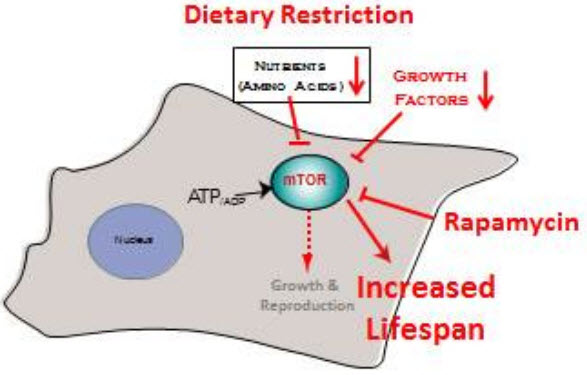Added drug allows rapamycin to slow aging without risking diabetes
May 23, 2014

This graphic outlines how rapamycin can mimic the effects of dietary restriction (credit: Oregon State University)
New research at the Linus Pauling Institute at Oregon State University suggests a fix for serious side effects of rapamycin*, a drug that appears to mimic the ability of dietary restriction to slow the aging process.
Laboratory mice that have received rapamycin have reduced the age-dependent decline in spontaneous activity, demonstrated more fitness, improved cognition and cardiovascular health, had less cancer, and lived substantially longer than mice fed a normal diet.
However, rapamycin has some drawbacks, including an increase in insulin resistance that could set the stage for diabetes, observed in both humans and laboratory animals. The new findings, published in the Journals of Gerontology: Biological Sciences, help to explain why that happens, and what could be done to address it.
It found that both dietary restriction and rapamycin inhibited lipid synthesis, but only dietary restriction increased the oxidation of those lipids in order to produce energy. Rapamycin, by contrast, allowed a buildup of fatty acids and eventually an increase in insulin resistance, which in humans can lead to diabetes.
Metformin prevents diabetes side effect
However, the drug metformin can address that concern, and is already given to some diabetic patients to increase lipid oxidation. In lab tests, the combined use of rapamycin and metformin prevented the unwanted side effect.
“If proven true, then combined use of metformin and rapamycin for treating aging and age-associated diseases in humans may be possible,” the researchers wrote in their conclusion.
“This could be an important advance if it helps us find a way to gain the apparent benefits of rapamycin without increasing insulin resistance,” said Viviana Perez, an assistant professor in the Department of Biochemistry and Biophysics in the OSU College of Science.
“It could provide a way not only to increase lifespan but to address some age-related diseases and improve general health,” Perez said. “We might find a way for people not only to live longer, but to live better and with a higher quality of life.”
“There’s still substantial work to do, and it may not be realistic to expect with humans what we have been able to accomplish with laboratory animals,” Perez said. “People don’t live in a cage and eat only the exact diet they are given. Nonetheless, the potential of this work is exciting.”
This work was supported by the National Institutes of Health. Collaborators included researchers from Oklahoma University Health Science Center, the Oklahoma City VA Medical Center, University of Michigan-Flint, and South Texas Veterans Health Care System.
*Rapamycin, first discovered from the soils of Easter Island, or Rapa Nui in the South Pacific Ocean, is primarily used as an immunosuppressant to prevent rejection of organs and tissues. In recent years it was also observed that it can function as a metabolic “signaler” that inhibits a biological pathway found in almost all higher life forms — the ability to sense when food has been eaten, energy is available and it’s okay for cell proliferation, protein synthesis and growth to proceed.
Called mTOR in mammals, for the term “mammalian target of rapamycin,” this pathway has a critical evolutionary value — it helps an organism avoid too much cellular expansion and growth when energy supplies are insufficient. That helps explain why some form of the pathway has been conserved across such a multitude of species, from yeast to fish to humans.
Age-related diseases include many of the degenerative diseases that affect billions of people around the world and are among the leading causes of death: cardiovascular disease, diabetes, Alzheimer’s disease and cancer.
Abstract of The Journals of Gerontology Series A: Biological Sciences and Medical Sciences paper
Dietary restriction (DR) is the gold standard intervention used to delay aging, and much recent research has focused on the identification of possible DR mimetics. Energy sensing pathways, including insulin/IGF1 signaling, sirtuins, and mammalian Target of Rapamycin (mTOR), have been proposed as pathways involved in the antiaging actions of DR, and compounds that affect these pathways have been suggested to act as DR mimetics, including metformin (insulin/IGF1 signaling), resveratrol (sirtuins), and rapamycin (mTOR). Rapamycin is a promising DR mimetic because it significantly increases both health span and life span in mice. Unfortunately, rapamycin also leads to some negative effects, foremost among which is the induction of insulin resistance, potentially limiting its translation into humans. To begin clarifying the mechanism(s) involved in insulin resistance induced by rapamycin, we compared several aspects of liver metabolism in mice treated with DR or rapamycin for 6 months. Our data suggest that although both DR and rapamycin inhibit lipogenesis, activate lipolysis, and increased serum levels of nonesterified fatty acids, only DR further activates β-oxidation of the fatty acids leading to the production of ketone bodies.